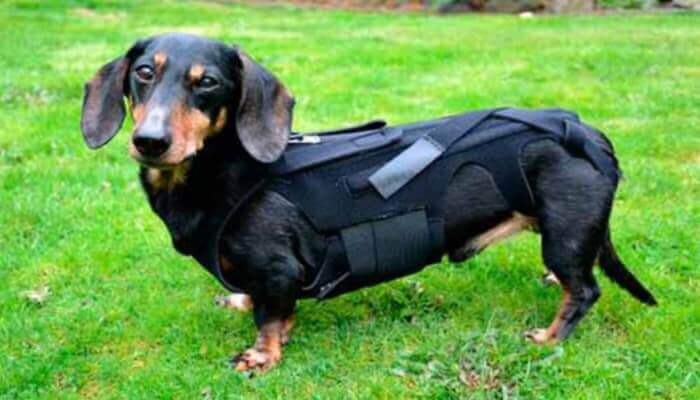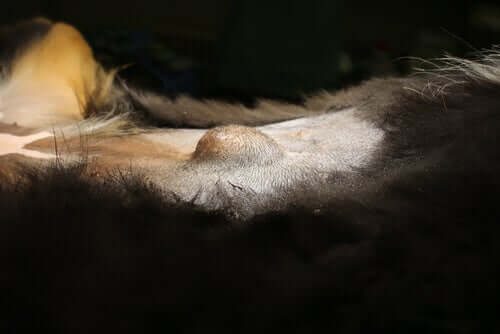Types of Canine Hernia: Are They Serious?

Animals suffer many pathologies that we sometimes forget about because we believe they can only affect people. For example, hernias in dogs. There are different types of canine hernia, and today, we want to talk to you about them.
What is canine hernia?
A hernia is a lump that forms in some organs inside the body, which can be seen in the form of swelling from the outside and can cause a lot of internal pain. The most common ones are umbilical and discal hernias.
Experts believe that the latter may be caused by the dog’s mother. Sometimes mother dogs stick too close to the puppy’s navel and don’t cut the umbilical cord properly.

Although hernias aren’t usually excessively severe, an old hernia that isn’t treated can cause serious problems. Therefore, most of the time the veterinarian will determine that surgery is indeed necessary.
Types of canine hernia
Some hernias may be more dangerous than others, so it’s important to recognize and treat them early. These are the different types of hernia we can find in dogs.
Inguinal hernia
The inguinal canal is a tube that sits between the abdominal muscles and starts with the inner inguinal ring and ends in an outer ring. That is to say, the abdominal muscles begin with one ring and end their length in another.
It occurs in the form of a lump and can be ‘absorbed’ by the abdomen, thus creating a hernia. These can become extremely large, so intervention to eliminate them needs to be immediate. It’s important to monitor our pet and search for these lumps from time to time, as these types of hernias could be congenital in nature.
Umbilical hernia
As in the case with humans, this is one of the most common herniae we can find in dogs. Obviously, dogs don’t have a belly button, but an area from which the umbilical cord comes out. If the mother, as we said before, gets too close to this area, it’s very likely that the puppy will end up developing a hernia.

It’s fairly common to see this type of hernia and they shouldn’t necessarily be considered a serious problem. However, we should never try to push them in or put anything on them to compress it. The size can reduce or shrink naturally and, if necessary, it can be surgically removed.
Diaphragmatic hernia
Because hernias are tissue bumps that come from an organ, they could displace other organs and create serious health problems as well. For diaphragm hernias, the most common symptoms are irregular heart beating and some shock symptoms may also be present.
Your pet may start having shortness of breath, and you may see its abdomen moving quickly. This is a hernia that needs to be treated urgently, as it affects the animal’s respiratory system, making it very dangerous.
Vomiting, diarrhea, and bloating would be the main consequences, as this type of hernia in dogs can occur in the stomach and intestines. They’re usually caused by trauma, which provokes a tearing of the diaphragm and causes the tissue to grow where it shouldn’t.
Herniated discs
This type of hernia in dogs is also caused by trauma from a blow or from a serious fall. This occurs when one of the discs between the vertebrae breaks or becomes inflamed. However, it can also happen to older dogs because of a degenerative deterioration of the discs.
A herniated disc can cause severe pain in the animal and, although surgery is highly recommended, it poses very important risks to consider.
Don’t forget to always keep an eye on your dear pet, because even when it might have a hernia caused by trauma, it may have happened when you were away. Search your dog once in a while and observe its body. As always, we recommend consulting a veterinarian without hesitation if you happen to see or notice any strange changes on your pet’s body.
It’s important that a dog with a hernia receives medical treatment quickly. We should note that dogs are unable to outgrow a hernia and it won’t heal over time. As a result, an untreated hernia can cause a great deal of pain for your dog and it could lead to medical complications.
All cited sources were thoroughly reviewed by our team to ensure their quality, reliability, currency, and validity. The bibliography of this article was considered reliable and of academic or scientific accuracy.
- Ramírez, A., Pastor, N., Durán, M. E., Gutiérrez, A., & Ezquerra, L. J. (2015). Hernia perineal en el perro, un estudio de prevalencia de 81 casos. Archivos de medicina veterinaria, 47(1), 71-75.
- Andrade Vargas, J. A. (2021). Hernia diafragmática de origen traumático en canino mestizo de 8 meses y complicaciones posquirúrgicas.
- Torres, D. (2015). Extrucion discal toraco lumbar en canino. Reporte de caso.
- Mitjans, L., & Torralba, M. A. G. (2018). Tratamiento quirúrgico de las hernias discales toracolumbares en el paciente canino. Universidad Zaragosa, 3-31.
- Builes Rodríguez, J. C., & Peláez Orrego, A. P. (2008). Hérnia de disco lombar num canino compatível com síndrome do paciente eutiroideo. Revista Lasallista de Investigación, 5(2), 83-89.